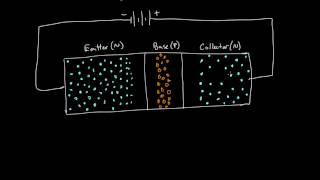Комментарии:

Does the negative charge created in (the right of) the base not repel electrons coming in from the left?
I understand that the positive charge pulls electrons from the base over to the right, but surely the negative charge created by the initial extra electrons filling the holes in the base would repel the electrons just as much as the positive charge would attract them. In my head this would cancel out the overall pull/push of any electrons leaving a delocalised sea of wandering electrons. If you then account for the positive terminal of the battery in the main circuit however, this WOULD provide an attraction for the electrons.
Where am I going wrong plz help.

This is the only satisfactory explanation of the workings of the transistor I have seen -- and I have seen many, either on video or in text form on the internet. Thanks Ben!
Ответить
Thank you! That's the clearest explanation of the workings of an NPN transistor using electron flow that I've discovered yet. It would be terrific if you would do a follow-on video on how a PNP transistor works using electron flow, which makes much better sense to me than conventional current flow, a fiction that defies science. Thanks again Ben!!
Ответить
So can each battery be different voltages? Could I join both negative terminals to the emitter and the load, and use the lower voltage positive to the base and connect the higher voltage positive directly to the load? To switch, say, a 12 volt battery with a 5 volt battery?
Ответить
How is a transistor typically driven on a refrigerator? I am getting .5v to my trabsistor base pin....that is not enough to fully turn on the transistor and causing me issues
Ответить
This is speed conversation but conversation is slow then it under standing very well. Pls
Ответить
Very well explained. I understood more in this 11 minutes video about how the transistor works than a 3 hours class lol.
Ответить
Im struglin with bias voltage on transistor
Ответить
well thats possibly the best transistor explanation i have ever seen. simple and short and yet somehow still covered everything, including the doping difference between collector and emitter, which is kind of crucial to understand why the transistor doesnt work right if you flip it around.
Ответить
Dear Ben Eater,
I hope this letter finds you well. I am writing to introduce you to an exploration I have been working on recently. I believe it has the potential to provide a new and unique perspective on the relationships between numbers.
As you know, the number line is a fundamental tool in mathematics, providing a visual representation of the relationships between real numbers. In my exploration, I have taken the idea of the number line and extended it in a new direction.
Imagine a number line where there is a unit circle for every increment in absolute value of one whole number. For example, a unit circle for 0 to 1, a unit circle for 1 to 2, and so on. Each unit circle represents all possible values between the two whole numbers that it lies between.
By doing this, we can represent any division of one increment between two whole numbers as a point on the unit circle. This provides a new way of visualizing the relationships between numbers, similar to how polar coordinates provide a new way of visualizing points in the plane.
I believe this exploration has the potential to provide new insights and understanding into the properties of numbers and their relationships, and I would love to hear your thoughts and ideas on the subject.
I look forward to hearing back from you soon.
Best regards,
Jon

Thanks
Ответить
Great explanation, keep the content coming : )
Ответить
A living legend.
Ответить
Good qualitative description of what's going on. Liked it! One description that I always found useful to understand transistor "action" is that once electrons from the emitter enter into the base, they are now "minority" carriers in the p - type base region, and will as such be swept across the reverse biased base - collector junction and into the n -type collector region.
Ответить
Thanks!
Ответить
Forward bias the emitter/base diode combo
Ответить
Life saving explanation.
Ответить
once the current gets going from Emitter to Collector why would it stop when the base current stops?
Ответить
You are the Emitter
We are the collectors
And this video is BASE!

This is the best explanation about transistors that i have ever heard, thank you!
Ответить
No repulsion due to the negatively charged electrons on the p-side of the base-collector junction (N-P-N transistor), towards the incoming electrons from the base-material? Also, they usually show that the EB junction is forward-biased while the CB junction is reverse biased, in your example however, you use a different configuration? I'm aware there're different configurations like Common-Base et cetera, could you explain them?
Ответить
I still don't understand why the collector becomes positive near the neutral zone between the collector and the base. If the silicon atoms are considered neutral, than the flow of electrons wouldn't make it positive but rather negative (more electrons in an atom than protons makes it negative).
Ответить
Thank God you exist man, this has been messin with my brain for a few days.
Ответить
You are best !!!!!!!!!
Ответить
For sure, the clearest and most complete explanation of a BJT on YT. Well done!
Ответить
The base must be charged with greater than 0.7 Volts in order for there to be an electric current in the main circuit. Of course, it is possible with a 0.7 Volt battery, but I think that is not how computers operate. How is the transistor given its 0.7-volt charge by computers? And how does the voltage decreases in order to turn the current off?
Ответить
Interesting.
Ответить
Bang. No resistor to limit the base current and collector current ! RIP to the BJT
Ответить
Kahn sent me
Ответить
if i forward biased the emitter and the base with a battery without conecting any thing to the collector
what would happen to the electrons in the collector?
would they flow through the base or would they just do nothig or their depletion region would decrease without letting them flow through the base?
whatever the answer please explain why it happens

What is the name of this software you're using for sketching?
Ответить
nice
Ответить
would a lot of electrons entering the smaller battery damage it when more electrons from the larger battery start going to it?
Ответить
Nice video, thanks for sharing :)
Ответить
♥♥♥
Ответить
What program do you use for those drawings?
Ответить
Currently sitting in my circuit analysis class bored out of my mind while the teacher is talking about calculating current in parallel circuits, decided to actually learn something. This is the best explanation of transistors I've found yet.
Ответить
The phosphorous electrons are in abundance in the emitter region, would you say this is why the transistor is able to amplify electrons to the collector and would you say those atoms are directly linear to the current at the base and that's what makes this an ideal semiconductor for audio amplifier applications?
thank you.

Get to the point dude. Takes forever repeating the same thing and adding side facts.
Ответить
You have a gift for explaining things, man.
Ответить
I have watched like.... 20 videos about how NPN transistors work and this is the only one that has made sense. Thank you.
Ответить
Thanks!
Ответить
Falling in love with Ben Eater's voice.
Ответить
THANK - YOU !had to watch dozens of other videos before I could figure it out :)
Ответить
the clearest explanation I've ever heard
Ответить
While that explains how a BJT turns on, I still couldn't understand how it turns off once the base current is stopped. Also, how the small emitter base current 'controls' the much larger emitter - collector current?
Ответить
👍 nice job.
Ответить
A bit messy. Not clear enough (incl. lack of proper base effect illustration) and too much tongue slips (or even mistakes, like "current >0.6V").
Ответить
By far the best video I have ever watched on the explanation of how a transistor works
Ответить




![[Craft Strategy] Made 10 Divine orbs pure profit in 1 hour. PoE 3.20 [Craft Strategy] Made 10 Divine orbs pure profit in 1 hour. PoE 3.20](https://invideo.cc/img/upload/VS1BSWxMNkRsdE0.jpg)





















